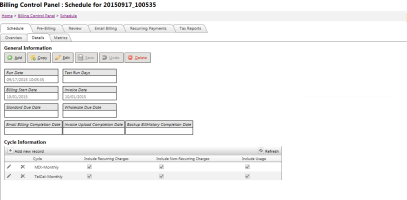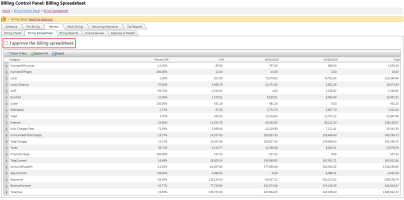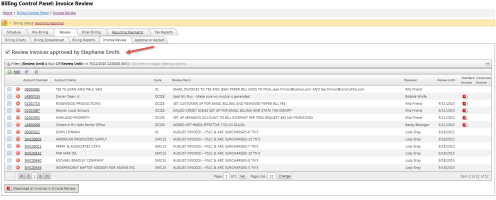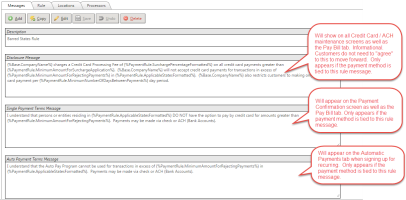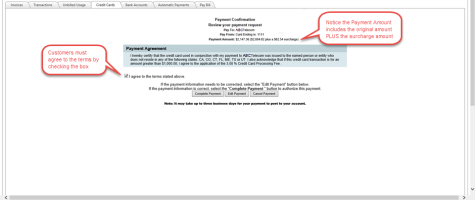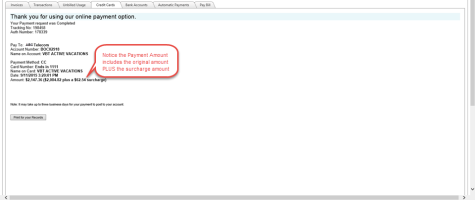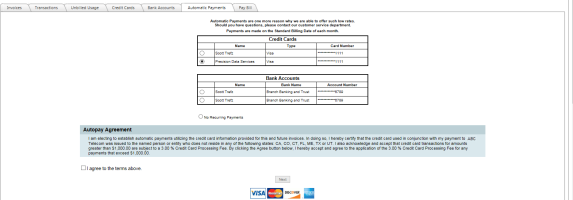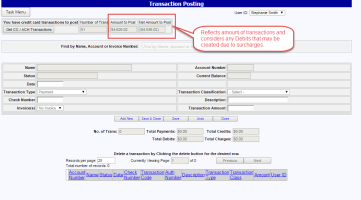2015-09 Superman Release Notes
Overview
The Superman release is just that...SUPER! Our developers have each been Super Men (they're all guys...so we can say that ha!) busy putting together an extremely robust release. Not only have they completed some outstanding billing tools for both the Operations Team and for Clients, they have also implemented a new module in TBS that allow Clients to now assess and help recoup the costs they are incurring for credit card processing with vendors.
While these two projects may not seem related, they both have an underlying goal of saving time, effort and costs for our clients. Be sure to check out each of these new robust features below.
The updates in this release are organized as follows:
- Featured Development
- General TBS - Enhancements & Bug Fixes
- Traditional Products - Enhancements & Bug Fixes
- Integrated Products - Enhancements & Bug Fixes
Taking "Control" in the Billing Control Panel!
Billing takes a lot of detail and hard work. We at Precision base our company's core on building and providing the tools necessary to generate timely and accurate invoices for our clients. We have been diligently analyzing our bill run practices and processes over the past year in an effort to help design and deploy billing tools that can help reduce inefficiencies and target specific areas for improvement. While the Billing Control Panel acts as our main set of tools for managing all bill run processing, we still found that there needed to be more Visibility and Client Control of the billing process.
We have found that the back and forth between Operations and the Clients is quite time consuming for our clients and that this could be resolved by giving both teams more insight into each others processes. This means that we needed to build the tools that allowed for greater control over review items, rerun requests and final approvals. We have rolled out several tools over the past year+ in the areas of Preparation, Review and Delivery. Items like the Data Verification quality checks, the dynamic Billing Spreadsheet, custom Billing Reports, PDF Invoice Review from TBS and embedded PDF links within ebills are all tools that let clients do their preparation, review data and invoices and then deliver these to the customers from inside TBS.
We are now taking that another step further by allowing Clients not only to schedule, but also monitor billing progress, request reruns and submit approvals all from the Billing Control Panel (BCP)!
These new billing resources are going to be rolled out on a client by client basis. Your account manager will be working with you to enable these tools and then walk you through the new features during your next bill run. Be sure to review the new tools below and get ready to take control!
Scheduling Bill Processing
Previously, scheduling bill runs was a task done behind the scenes and there was no way for the Client to have a view into the schedule outside of what was discussed with the Account Manager. Once the new tools are released, Clients will be able to view and manage bill runs using the new Schedule tab under the Billing Control Panel. This new Schedule tab will provide insight to the Client as to the schedule for bill processing as well as the current status of any scheduled items.
Adding a new record or selecting an existing entry will display the Schedule Details. This screen allows for the following options to be setup:
- Run Date - The date and time for the scheduled bill run. Entries must be entered at least 5 minutes in the future. A backend monitoring service will check for new entries every 5 minutes. There should be one entry per production bill run per day. See more information below regarding reruns.
- Important Note: The run date will determine the BillingCycleID for the bill run. Previously, Billing Cycle IDs matched the Invoice date, i.e., 20150901 for Sept 1 2015 invoice date. Going forward, if the 1st fell on a Saturday, and the client wanted to run on Friday, August 31st, the Run Date would be 08/31/2015 8:00:00 and the Billing Cycle ID would then be 20150831_080000.
- Test Run Days - Used for test/preruns. Internal only for now. Your account manager will mange test/preruns. Management of test/preruns by the Clients will be part of a future release.
- Billing Start Date - The start date used when calculating charges for the run
- Invoice Date - The date that appears on the invoice
- Standard Due Date - Due date that prints on the Standard/Corporate Customer invoice. Note: Leaving this blank will print "Due Upon Receipt"
- Wholesale Due Date - Due date that prints on Wholesale Customer invoices. Note: Leaving this blank will print "Due Upon Receipt"
- Email Billing Completion Date - Readonly date showing the day that email billing was completed for this bill run
- Invoice Upload Completion Date - Readonly date showing the day PDF invoices were loaded to their final online location
- Backup BillHistory Completion Date - Readonly date showing the date that the Billing History database back was complete. This is done as part of the bill run automatically.
- Cycle Information - Allows the selection of one or more billing cycles to be added to the bill run as well as flags for Including Recurring Charges, Including Non-Recurring Charges and Usage. These options allow runs to be setup throughout the month for one-time/NRC charges only or Usage only.
On Screen Status Notifications
Throughout the process, new Billing Status notifications will appear in the top Notifications area of TBS. These statuses will show any users with access to the Billing Notifications module exactly where the system is in regards to the billing process. This allows all team members to be up to date on progress and help plan for next steps. Below is an overview of the descriptions that may be present throughout a bill run.
Billing Statuses:
- Not Started - This represents a billing that has been scheduled, but not yet started. This notification appears only on the Schedule Details tab for the scheduled bill run entry.
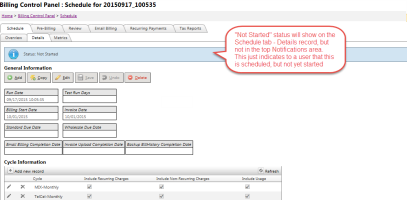
- Ready to Start - Indicates that the back end monitoring service has detected a bill run that is schedule to start now. This status may show briefly while the system is preparing to start the bill process. This status will show in the main Notifications area as well as the Details tab of the scheduled bill run.
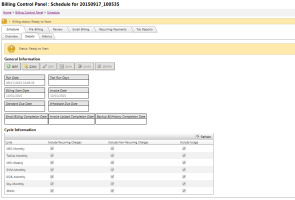
- Running Billing - Indicates the main bill processing steps are running. Data snapshots have been taken and any changes after this point will not be reflected in the billing outputs. Note: During this status, the Billing Spreadsheet and the Approve or Restart tabs are unavailable.

- Awaiting Approval - Indicates that the billing process has compiled all the charges and usage and the Billing Spreadsheet, Billing Reports and Review Invoices are ready for the Client to review. Once the client reviews these items, they can approve each by clicking the "I approve..." check boxes, which will enable the main Approve button on the Approve or Restart tab. If issues are found, the Client can fix these issues in TBS and then use the Restart Billing button to rerun the bill run reflecting any TBS changes that have been made.


- Ready to Restart - Indicates that the Restart Billing button has been clicked. This status will not show in the Notifications area, but will show as a status on the Approve or Restart tab once the Restart Billing process is triggered.

- Approved - Indicates that the Client has approved each of the main review items (Billing Spreadsheet, Billing Reports and Review Invoices) as well as triggered the Main Approval. Once the main approval button is clicked, the Approve or Restart tab are no longer available. Additionally, the approve checkboxes on the review items no longer show. This status triggers notifications to the Account Manager and the TBS system that billing can move forward.
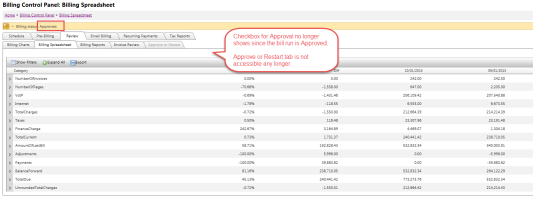
- Running Post-Approval Steps - Indicates that the bill run has been approved and data is now working to be reflected in TBS including accounting transactions and production invoices being generated and tied to each account.
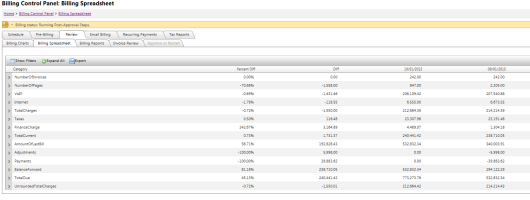
- Awaiting Finalization - Awaiting the final steps before the bill run can be considered complete. Email billing can be triggered at this point.

- Finalizing - Performing final bill run steps and cleanup including any file moves or database backups
- Complete - The bill run and all steps outside of Email billing and Recurring Payments is complete. All important dates are filled in on the Schedule tab to indicate exactly when items occurred.
Note: Email billing and Recurring Payments can be ran outside of a bill run day/process if desired.
Email Notifications
Client email notifications that correspond to the above statuses are coming soon!
Review, Rerun & Approve Options
Once billing has been scheduled and ran, clients will then have the ability to not only review the Billing Reports, Billing Spreadsheet and Invoice Review items, they also approve these items directly in TBS. Approvals of each item will then enable the master Approve Billing option that can trigger notifications to the Account Manager and allow the system tools to move forward with the next steps for billing. Previously, this required manual emails and/or phone calls to your Account Manager. This notification and trigger can now be done directly from TBS via the Approve or Restart tab within the BCP.
Find something amiss during the Review process? There is now also the ability to request billing Reruns directly from TBS via the Approve or Restart tab. This process also used to require a manual intervention to be made by Account Manager after a call or email from the Client. Clients no longer need to wait for a rerun to be triggered. Once they have their data fixed, they will have the option right in the Billing Control Panel to run everything again. Please note: CDR records will not change. Only call data records that were part of the initial snapshot will be reflected in the rerun.
Account Managers are notified of all restarts and approvals to still ensure that everything is running smoothly and that all QA is being done at the appropriate times. By triggering and notifying from TBS, this eliminates the back / forth inefficiencies of email or phone calls.
Access & Permissions
Permissions and access have been updated to support the new tabs and tools. See the table below for an outline of what permissions are needed to access each area.
| Tab | Permissions |
| Schedule | Billing.Access, Add, Update, Delete or Admin |
| Pre-Billing | Billing Access |
| Review (Charts, Spreadsheet, Reports, Invoice Review, Approve) | Billing. Access - Allows user to check the individual approve items
Billing.Admin - Final Approval button |
| Upload Invoices | Billing.Update |
| Email Billing | Billing.Update |
| Recurring Payments | Accounting.Update |
| Tax Reports | Billing.Access |
Billing Status Notifications can be viewed by users who have access to the new Billing Notifications module. This new module has been added to the Billing security group with the release.
Payment Processing Rules & Recouping Credit Card Processing Fees
Paying by credit card or Bank Account is a convenience. And while cash flow is an obvious benefit of this immediate form of payment, we understand that it also can come with cost to our clients when processors impose processing fees for these transactions.
Recouping these fees is critical so that clients can offer this service and not impact profits. Additionally, ensuring that customers review and agree to payment terms is vital. With this release, a new module is now available that will allow clients to define and manage their custom Payment Rules in TBS that can enforce customer agreement to payment terms and conditions as well as optionally apply percentage based surcharges to credit card transactions.
Payment Rules Management
The new Payment Rules module consists of two components: Customized Payment Messages & Advanced Payment Rule Settings.
The Customized Payment Messages allow the clients to specify their own payment terms/agreements, disclosure messages and error messages that will be displayed on the ACH, CC, Pay Bill and Automatic Payment pages. These messages can be setup regardless of the above Advanced Payment Rule Settings and can be used for:
- Disclosure Messages - this is a general payment disclosure message that will be displayed at the top of the Credit Card Edit, ACH Edit, and Pay Bill screens.
- Single Payment Terms Message - the message to be used for One Time / Single Payment User Acceptance
- Auto Payment Terms Message - the message to be used for Auto Payment User Acceptance
- Over Minimum Rejecting Payment Message - the error message to be displayed when a system rejects a payment for being over “Minimum Amount For Rejecting Payments”
Management of these Payment Rule Messages can be found by going to Utilities -->System Administration --> Payments --> Payment Rules and then use the Messages tab. Once a Message is setup and tied to a Processor via the Processors tab, it will automatically be implemented for accounts using that Processor.
Payment Rule messages can support replaceable values such as Company Name, Applicable States, Minimum Amounts defined in the Payment Rules defined above, etc. that can help customize the Terms and other messages for each client. Replaceable values should be enclosed in {% %} in order to work properly. Please work with your Account Manager for a complete list of values that can be used.
The Advanced Payment Rule settings allow clients to take the messages one step further and also define rules that can be applied to the Credit Card and / or ACH transactions. These rules can have a variety of applications and take into account several parameters before allowing payments of certain types or amounts to be made, limit the amount a user can pay via CC or ACH, as well as apply percentage surcharges if the criteria is met. Each item is designed to work in conjunction with other settings in order to apply the payment rules.
For example, many credit card processors impose fees for transactions, particularly if they are of a larger amount. Some states however, may not allow the fee to be applied despite that credit card processor will still apply a fee. To best support this scenario, two rules would likely be setup. 1 -A Payment rule that applies a 3% fee on any payments over a minimum threshold. 2 - A Payment rule that would not allow payments greater than a specific threshold within certain states that don't allow the fee. This would prevent customers from making payment over the minimum, but only in locations that don't allow the fee.
These two rules combined would allow the client to impose a 3% surcharge on payments of their choosing and also prevent payments that may not be able to have the fee recouped due to state regulations.
There are many different ways to configure the Payment Rules to meet each Client's needs. Items that can be configured:
- Surcharge Percentage - Percentage point that should be applied to the total payment amount being requested. See below on how this surcharge is handled and applied to the account.
- Minimum Amount for Surcharge Application - Minimum payment amount that will be considered for a surcharge, if defined. Anything equal to or greater than this amount will have the surcharge applied (pending any other rules defined).
- Minimum Number of Days between Payments - Allows restrictions to be made on the number of payments that can be made during a time period. This can be useful if the Minimum Amount for Surcharge Application is enforced to prevent customers from making multiple, below minimum amount payments within the payment period to avoid surcharges.
- Minimum Amount for Rejecting Payments - Allows payments over a certain amount to be prevented. Again, this can be combined with the other payment rules above, i.e., Applicable states, to limit large payments in states that may not allow a surcharge to be applied.
Management of these Payment Rules can be found by going to Utilities -->System Administration --> Payments --> Payment Rules and using the Rules tab when setting up a new Payment Rule. Note: This tab is only enabled for clients that have arranged for this module/service. Please be sure to contact your Account Manager for more information.
Implementing Payment Rules & Messages
Applicable Locations - Once a Payment Messages and/or Rule are setup, they can then be configured to apply to only certain Locations (Country/State) if necessary. Management of these Payment Rule Locations can be found by going to Utilities -->System Administration --> Payments --> Payment Rules and using the Locations tab when setting up a new Payment Rule.
Payment Processors - The last and most important step in implementing a Payment Rule is to apply it to a Payment Processor. Since Payment Processing is driven by and underlying Payment Processor, Payment Rules must be linked to the appropriate Payment Processor so they are applied to the correct accounts. This allows for multiple rules if multiple processors exist, or the flexibility to have different messages and rules based on Credit Card vs. ACH.
Payment Rules & Messages Interface Impacts
The Credit Card / Bank Accounts payment interface has been updated to now show payment Disclosures, Terms and Agreements, force users to agree to these terms as well as notify users of any additional surcharges or rules that may apply to their payments.
Messages can be customized based on the Client's payment terms. The notifications include a Disclosure, Automatic Payment Notification or Single Payment Notification and error messages.
*Please note minor layout changes have been made to the CC/ACH pages to now support the disclosure and terms. Additionally, managing Automatic payment accounts must all be accomplished via the Automatic Payments tab in order to force customers to properly accept the appropriate terms.
One Time Payment - Credit Card
Terms Agreement & Complete Payment
Credit Card - Payment Rule Error - Over Minimum in Barred State
Credit Card - Payment Rule Error - Minimum Number of Days between Payments
Receipt / Confirmation
IMPORTANT: All maintenance of Automatic Recurring payments must now be accomplished via the Automatic Payments tab to enforce the acceptance of AutoPay terms. Links have been added to the Credit Card / ACH maintenance screens as well as indicators if the card or bank account is selected for recurring payments. This change was made to enforce customers to view and accept the AutoPay Terms and Condition prior to signing up for recurring payments.
Notification / Agreement messages will appear at the bottom of the automatic payment sign up page that displays a customized message that can be defined by the client. It requires the user to agree to the terms in the agreement box before they can move on to the next page and finalize their automatic payment sign up.
Payment Terms & Agreements Tracking
Disclosures, Terms and Agreement messages can all be setup regardless of additional Payment Rule parameters. When in place, all TBS users, regardless of type, must agree to the Terms and Agreements presented prior to submitting payments or signing up a payment method for recurring payments. This includes internal users that may take/make payments or setup recurring preferences on behalf of customers. The time/date of the acceptance will be tracked within TBS. Customer Metrics will allow Clients to view activity on this acceptance if desired.
Exempting Customers from Processing Surcharge
Options have been added to allow a customer to be flagged as exempt from certain portions of a Payment Rule. Two new fields have been added to the Account Settings --> Invoicing tab that will:
- Prevent Surcharge
- Allow Payments Before Minimum Number of Days
Applying the Surcharge
When a Payment Rule has a Surcharge enabled, the following steps are followed for validating and applying the surcharge:
1. Check to see if a rule exists for the customer's payment processor and the geographic location on the credit card or bank account record.
2. If the customer has pending transactions, prevent the payment (unless their system has been configured to allow multiple pending payments)
3. If the rule's Minimum Number Of Days Between Payments is set AND the customer's Allow Payments Before Payment Rule Minimum Number Of Days on the Invoicing tab is not set, check to see if any real time payments have been submitted through payment processing within the specified date range. If any exist, prevent the payment and show the appropriate error message.
4. If the rule's Minimum Amount For Rejecting Payments is set AND the original amount of the payment is equal to or greater the Minimum Amount For Rejecting Payments, prevent the payment and show the appropriate error message.
5. If the rule's Surcharge Percentage is set AND the original amount of the payment is greater than or equal to Minimum Amount for Surcharge Percentage Application AND the customer's Prevent Payment Rule Surcharge is not set, apply a surcharge.
Surcharge Transactions to Customer Account
The following transaction types are created for surcharges by applying Payment Rule logic:
For payments, a separate DEBIT transaction for the surcharge amount is created
When crediting a payment that had a surcharge applied to it, a separate CREDIT transaction for the surcharge amount is created. If a partial credit is applied, the corresponding percentage of the original surcharge amount is refunded as well.
For example, envision a 3% surcharge has been applied to a $1000 payment, resulting in a $1030 payment transaction and a $30 debit transaction for the surcharge. Refunding $500 of this payment will result in a $515 debit transaction and a $15 credit transaction for the surcharge.
Surcharge transactions have an authorization number of 'Surcharge'.
Transaction Posting Screen Updates
The Transaction Posting screen, real time payments section has been updated to now reflect the surcharges properly.
Handling payments that don't meet Payment Rules
Payments that don't meet payment rule criteria in TBS are not submitted to the underlying payment processor. However, a Payments Log record is still written giving the reason for TBS refusing the payment. This allows failures for payment rule reasons to be processed using the same process that is in place for processing failures from payment processors themselves. For recurring payments, this is the existing report that shows the results of the batch process.
General TBS - Enhancements & Bug Fixes
46394 - Prevent FTP Incomplete Uploads
In order to prevent incomplete files from being uploaded using the TBS FTP process (primarily used for gather CDR and Provisioning files), new logic has been implemented that will now always overwrite (regardless of the job's overwrite files option) 0-byte files on FTP/SFTP servers. This is to resolve issues with servers that save a 0-byte file when a transfer is interrupted.
48554 - System Settings Admin
A new Administration page is available for System Settings. This is a beta admin screen that will be elaborated on in future releases that will allow clients to change some default application settings. Currently, Clients can only update their Company Name and their Default Account Number Scheme (if not applied at the Group level).
This page will also show the current system version and version number.
50431 - Bug: Download Invoice Tab on Cust. Portal Not Working
The Download Invoice tab within the Invoice viewer was not allowing PDFs to be downloaded. This has been fixed.
Traditional Products - Enhancements & Bug Fixes
50299 - Bug Fix: Facilities Tab
A bug on the Facilities tab that prevented users from adding / editing new records has been corrected.
Integrated Products - Enhancements & Bug Fixes
50441 - Limiting the Replication of Products to 1000
Attempting to replicate over 1000 Products at once now gives a warning message and prevents the action.

